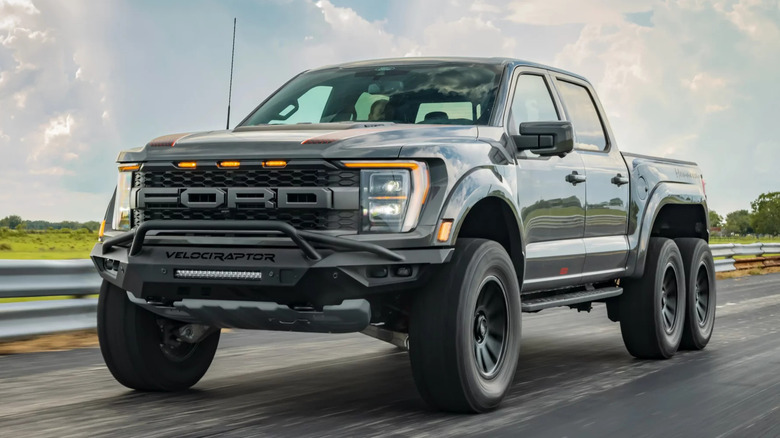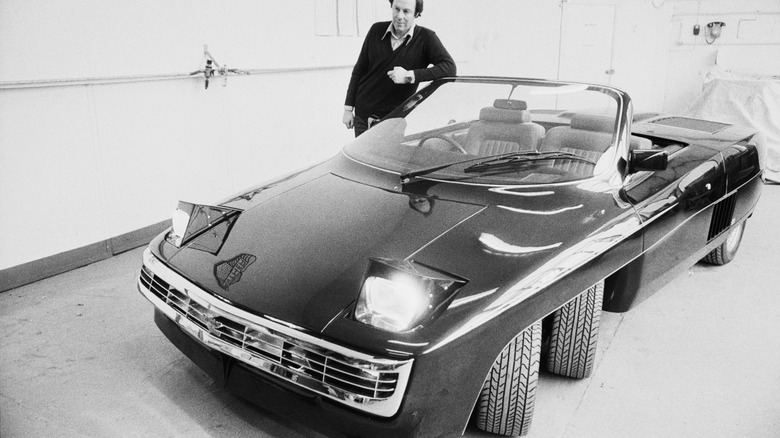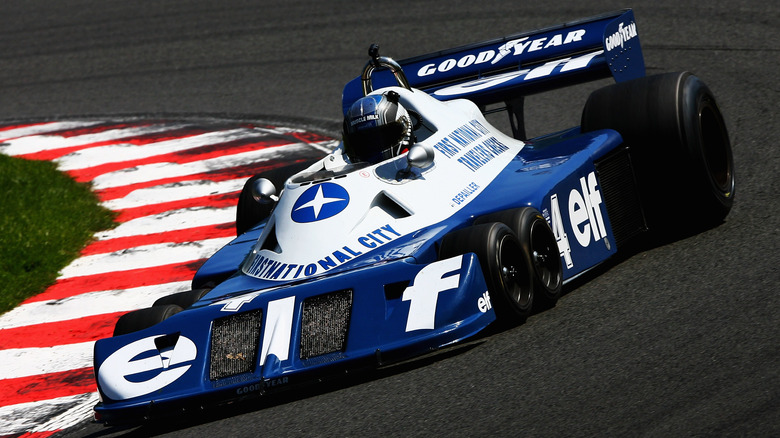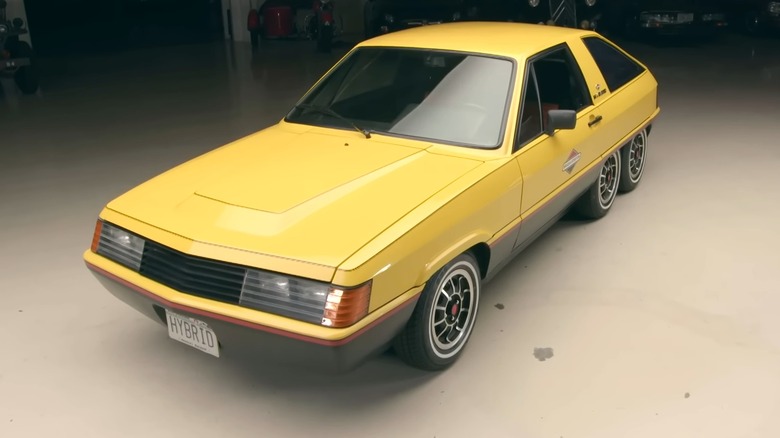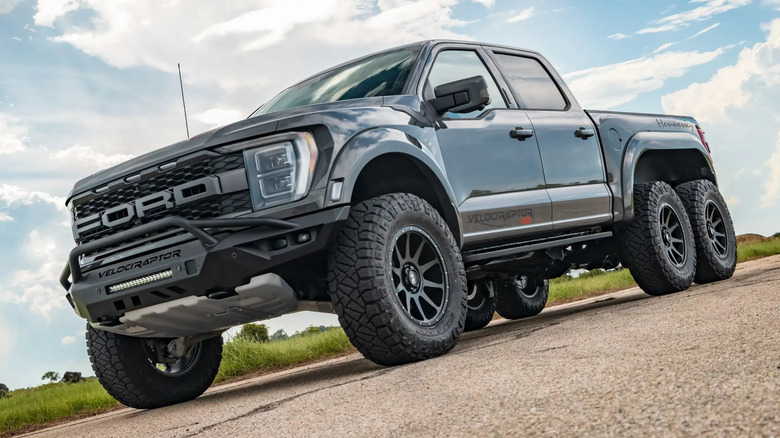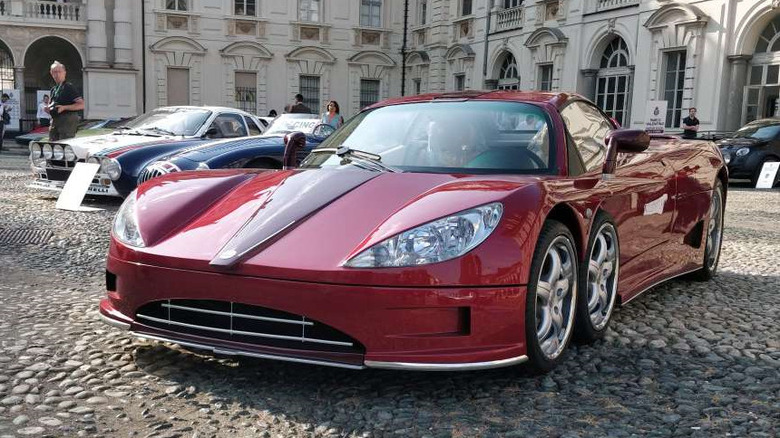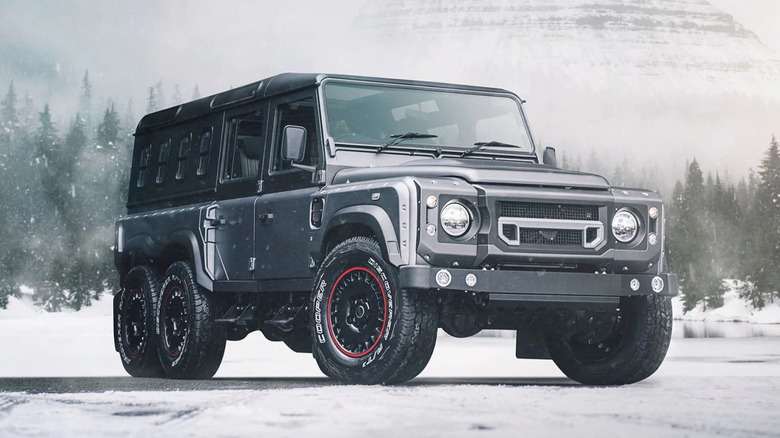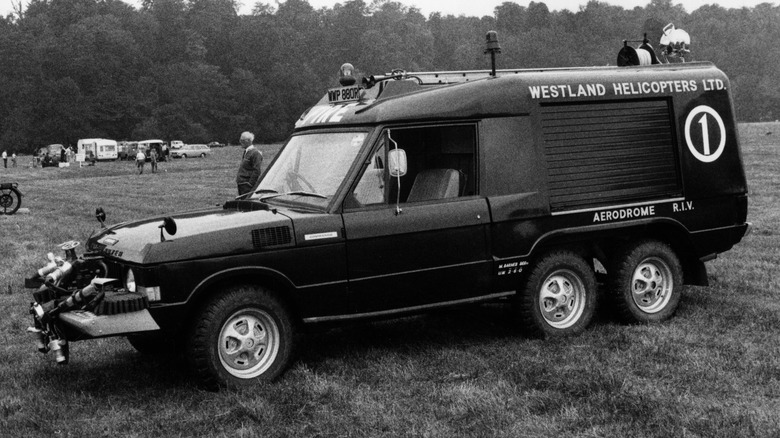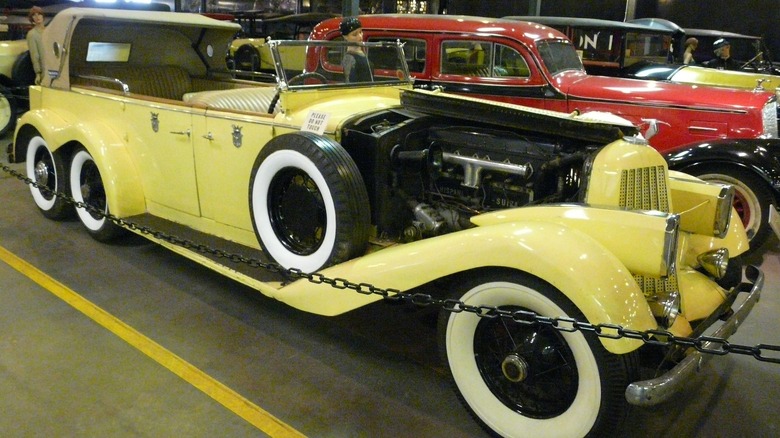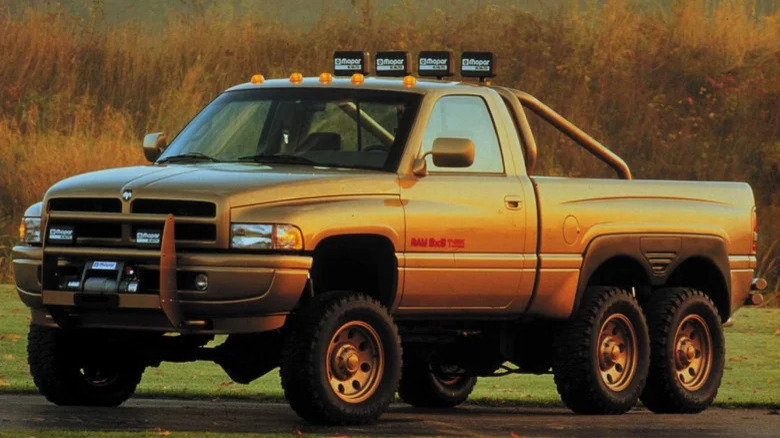10 Of The Coolest Six-Wheel Vehicles Ever Made
Six-wheeled vehicles, at first glance, might seem more of a novelty than anything else. After all, the vast majority of cars and trucks on the road make do with four wheels, so surely adding an extra pair is a bit pointless? Well, that's not entirely true –- in fact, over the years, carmakers have cited all sorts of reasons as to why they include the extra axle, from off-road capability to superior high-speed handling. Some attempts, admittedly, have been more effective than others, but whether they've been designed for Formula 1 racing or as all-terrain emergency vehicles, the list of superior 6x6 vehicles is longer than many would think.
The range of six-wheeled vehicles in automotive history remains relatively small, but almost all of them have unique backstories and most are extremely rare. From the Italian supercar that took 30 years to design to the lawnmower company that made a six-wheeled hybrid city car, these 10 cars are among the coolest six-wheelers we've seen.
Mercedes-Benz G63 AMG 6x6
In recent years a slew of trucks and SUVs have gained six-wheeled versions, either from the factory or thanks to third-party conversions, but the truck that started the trend was the Mercedes-Benz G63 AMG 6x6. The first six-wheeler G-Wagon was designed for the Australian army but was later adapted for sale to civilians in a limited production run. The G63 AMG 6x6 featured both the drivetrain and the interior luxuries of the standard G63 AMG –- that meant a 536 horsepower twin-turbo V8 under the hood and a cabin featuring fine leather and wood trim.
The price for this huge, outlandish truck sat somewhere around half a million dollars, making it one of the most expensive Mercedes-Benz cars ever sold at the time. Nonetheless, customer demand was very high, and the automaker sold its entire run of build slots long before the last example was completed in 2015.
Unlike some other jacked-up SUVs that function primarily as show vehicles, the G63 AMG 6x6 was a highly capable off-roader, with 18 inches of ground clearance and 37-inch tires. It was primarily designed for blasting through the desert, but it was just as happy crawling through mud and water, with up to 39 inches of fording depth. For reference, the new Hummer can only wade through 32 inches of water in Extract mode and only 26 inches on its default settings. It's safe to say, then, that the Mercedes 6x6 was exceptional in every sense of the word.
Panther Six
Built by a small British company with big ambitions, the 1977 Panther Six was the subject of some wild claims. It was said to boast a top speed of over 200 mph, an unbelievable figure for the time, and to be powered by an 8.2L twin-turbo Cadillac V8 engine with a reported output of more than 600 horsepower. It would be built in an ultra-limited run, with 15 orders on the books for wealthy clients. It would also be one of the most expensive cars in the world, costing significantly more than the priciest Ferraris of the era.
The reality, however, was slightly different: no one ever tested the car's top speed or its power output. The originally planned production run was hit with delays after Pirelli backed out of a contract to produce bespoke tires for the car, and then the project was canceled after the firm ran into financial trouble. The price? Considering only two examples were ever built, and only one of those was finished by the time Panther went bankrupt, it's hard to say.
Of those two cars, one is presumed to be in a collection in the Middle East, although its exact whereabouts are unknown. The second car appeared at a Bonhams auction in 2011, having been rescued from a Greek customs impound after its Bulgarian former owner was jailed. It sold for the surprisingly reasonable sum of €41,400 (roughly $57,000 at the time) and hasn't been seen in public since.
Tyrrell P34
The Project 34 started life as the brainchild of Derek Gardner, who was looking for unusual ways to give the Tyrrell F1 team he was working for an advantage on the grid. By adding two extra front tires, he thought, it would be possible to increase overall grip, and as a result, the car would need less aero. It was an extremely unconventional idea, but after presenting it to his bosses the development green light was given and work started on the car in secret. The finished car debuted on the track at the Spanish Grand Prix in 1976 and proved to be competitive, although it suffered a race-ending brake failure before it could cross the line.
Subsequent races also proved the car had pace, culminating in the car's race win in Sweden later that year at the hands of Jody Scheckter. However, the same unique design that gave the P34 its winning edge eventually ended up being the reason why it fell behind the rest of the pack. Its front tires, made by F1 supplier Goodyear, weren't subject to the same level of development as the standard-sized tires used at the car's rear, and eventually, the grip imbalance made it uncompetitive. A few years later, the use of six-wheeled cars was banned altogether by F1 race organizers, making the P34 the only six-wheeled car ever to win an F1 race.
Briggs & Stratton Hybrid
While most six-wheelers are about performance, all-terrain capability, status, or a mix of all three, the Briggs & Stratton Hybrid is very different from the rest. For starters, it wasn't built by a car manufacturer –- Briggs & Stratton is instead known for its small engines, which can be found powering everything from snow blowers to lawnmowers. The car was created during the Oil Crisis of the '70s as an experimental prototype to prove that a small-engined hybrid car was a viable means of transportation. It featured a 694cc two-cylinder engine, which produced just 18 horsepower and was assisted by a set of lead-acid batteries.
Total power output might have been very modest, but the car's relatively lightweight design — at least for the era — meant that it could reach the speeds required for urban driving both under gas power and electric-only power. Its official top speed was claimed as 68 mph, although in an episode of Jay Leno's Garage, the host only managed to achieve 60 mph on the road. Its six wheels were a necessity to support the weight of the batteries, although they served to draw attention to the car as well –- the car was primarily a promotion for its maker, after all.
While the prototype was innovative, the idea of small, hybrid powertrains didn't catch on with the American public, leaving the Briggs & Stratton Hybrid to slip into eventual obscurity.
Hennessey VelociRaptor 6x6
The closest thing Ford fans have to a factory-backed 6x6 version of the F-150 Raptor is the Hennessey VelociRaptor 6x6, a custom-designed monster truck built in extremely limited numbers.
The Hennessey VelociRaptor 6x6 was first unveiled back at the SEMA show in 2017 and is now in its third generation. The original boasted 605 horsepower and 622 lb-ft of torque, while the latest variant produces 558 horsepower and 672 lb-ft of torque. All that power comes at a cost, of course. The launch truck costs $349,000, including the donor F-150 Raptor, and since then, pricing has risen to $399,950. No matter the generation, each VelociRaptor 6x6 boasts a slew of off-road upgrades to make it even tougher than a standard Raptor, including dual locking rear axles and upgraded suspension.
The truck bed is eight feet long, a full 2.5 feet longer than standard, and huge 37-inch off-road tires complete the oversized look. It's available from certain Ford dealers and through Hennessey with a standard 3-year/36,000-mile warranty, just for peace of mind. That warranty might not cover any damages sustained while using the truck as a high-speed desert racing missile, but it's highly unlikely that will stop any owners from doing exactly that. After all, what's the point of buying a toughened six-wheeler if you only ever drive it on the road?
Covini C6W
Much like the F1 cars from which it reportedly drew inspiration, the Covini C6W gains real-world performance benefits from its unconventional wheel layout. Covini highlights a few of them: improved road holding, optimal aerodynamics at the front of the car, and reduced risk of aquaplaning. The C6W's story is an unusual one, with its developers reportedly spending around three decades designing the car as a side project to the family business before entering limited production in the late '00s.
It's not clear how many have been built, as original reports said the company was planning to build six examples a year, but only a handful of cars have ever made public appearances. Stats posted on the company's website claim a top speed of 186 mph and a 0-62 mph time of 3.9 seconds, made possible thanks to the car's 440 horsepower 4.2L V8 engine.
Very few journalists have ever driven the car -– former Jalopnik writer Bill Caswell briefly drove the car at Goodwood in 2011, but not at speed -– so it's very difficult to verify how it performs on the road. However, Caswell was impressed at the time, calling the car's turning "silky smooth" while saying it felt very different to any car he'd previously driven.
It appears from Covini's website that the car is still available to order through commission, and examples were still being shown at concours events as recently as 2019. However, pricing remains a mystery.
Kahn Design Flying Huntsman
British boutique coachbuilder Kahn Design has been making 6x6 vehicles for several years now, with one of its most long-running designs being the Flying Huntsman 6x6. It's based on the Land Rover Defender but extends the standard SUV's footprint by nearly 35 inches, creating room for up to nine occupants in the process. As with most coachbuilders, the specifics of each example can be configured to a customer's exact tastes, but all will feature luxury interior upholstery far exceeding that of any standard Land Rover product.
To give the Defender a suitably burly powerplant to match its exterior, Khan fits a GM V8 engine with a power output north of 400 horsepower. That figure can be further boosted upon request. A panoramic glass roof makes the Flying Huntsman's cabin brighter and airier than a standard Land Rover, too, all while keeping the off-road capability that makes the original Defender a long-standing favorite among enthusiasts. Pricing for the truck isn't specified, but a pristine 2018 model with just 100 miles on the clock is for sale for £500,000 (roughly $610,000) through Kahn's used car division at the time of writing.
Land Rover Range Rover 6x6 Carmichael
Decades before the Mercedes-Benz G63 AMG 6x6 put six-wheeled off-roaders in the spotlight, British conversion specialist Carmichael created around 400 six-wheeled Range Rovers, mainly for commercial clients. They were built mostly as emergency vehicles, with some seeing service as fire trucks and some used as mountain rescue vehicles. A small number were also built for civilian use, although the exact number isn't known. Of the original run, only a small fraction are still around today, most having been retired or scrapped after their years of service.
That makes the few that do still exist sought-after collectors' cars, especially those in non-emergency guise. However, as owners of any older Range Rover will be all too aware, rust is a common issue, and so most surviving examples of the Carmichael will have either undergone some restoration or require some before being roadworthy again. The company behind these unique six-wheelers has since been bought out and still makes fire trucks, although it no longer produces its Range Rover conversion.
Hispano-Suiza H6A Victoria Town Car
One of the earliest known six-wheeled cars is the Hispano-Suiza H6A Victoria Town Car, a one-off creation that is now kept in the Forney Museum in Denver. It was first built in 1923 and was sold to D.W. Griffith, the prominent movie director, and later appeared in multiple films, including the 1933 movie "My Lips Betray." Its unique coachwork was built by Leon Rubay and would turn out to be one of his last projects before ill health forced the closure of his company.
The H6A reportedly cost Griffith $35,000 at the time, which, accounting for inflation, equates to roughly $630,000 today. The H6A is the only known six-wheeled example of the Hispano-Suiza H6, of which around 2,350 examples were built between 1919 and 1934. Most were powered by a 6.5L six-cylinder engine making around 135 horsepower, making the H6 one of the most powerful cars of its day, as well as one of the most imposing — especially in six-wheeled form.
[Featured image by Piotrus via Wikimedia Commons | Cropped and scaled | CC BY-SA 3.0]
Dodge T-Rex
The Dodge T-Rex is arguably one of the strangest vehicles built by the Chrysler Corporation, but it's also one of the coolest. Unveiled at the SEMA show in 1997, the T-Rex was based on a Ram 3500, with its wheelbase lengthened to accommodate the extra pair of wheels. Under the hood sat the 8.0L V10 from the Viper, churning out 497 horsepower and 593 lb-ft of torque. The six-wheeled layout was reportedly chosen instead of opting for a conventional dualie setup as the 6x6 layout increased traction and decreased overall width, making the truck more maneuverable.
Like many six-wheeled vehicles, its 6x6 mode was not full-time -– during conventional driving, only the rear two axles were powered, but the front axle could be connected to the drivetrain for when all six wheels were needed. The T-Rex was only ever built as a show car, but a small number of individual Ram owners created their own copycat builds over the years.
While the original never saw production, there is now a spiritual successor on the market for anyone with deep enough pockets in the Hennessey Ram TRX 6x6. With over 1,000 horsepower on tap and just 12 units available for the 2023 run, it's the wild low-volume special that Dodge never dared to make.
